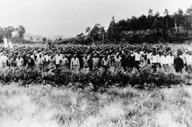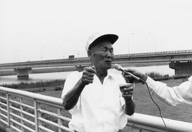Zainichi History
1Shin Ki-soo
Shin Ki-soo is a filmmaker from Osaka known for his research into the history of Korean envoys to Japan. Six years were spent on this film collecting materials and testimonials to carve out zainichi history using real film footage and testimony.
Until the Day of Liberation: Retracing Korean Japanese History
(“Kaiho no hi made: Zainichi Chosenjin no sokuseki”) JAPAN / 1980 / Japanese / Color / 16mm / 210 min
JAPAN / 1980 / Japanese / Color / 16mm / 210 min
Narrative Structure, Original Concept: Shin Ki-soo
Photography: Takaiwa Hitoshi
Editing: Karashima Hajime
Sound: Sasaki Masahiko
Music: Sekiguchi Takashi
Narrator: Ito Soichi
Supervisor: Pak Kyong-sik
Planning, Production: Seikyu Bunka Hall (Representative: Shin Ki-soo)
Production Company: Rodo Eigasha
Source: Kang Hak-ja, Osaka Human Rights Museum
The founder of the Seikyu Bunka Hall in Osaka and an authority on Korean envoys to Japan, Shin Ki-soo spent his life collecting visual materials, and drew upon them to make this film about the history of zainichi Koreans in pre-war Japan. From the massacre of Koreans at the construction site of the Nakatsugawa hydroelectric power plant in Niigata Prefecture and the joint struggle of Korean and Japanese factory girls at the Kishiwada cotton mills to the dispute at the Sanshin Railroad construction site in Aichi Prefecture and the strike at the Aso coal mines in the Chikuho region of Kyushu, this film uncovers and assembles valuable testimony from many people who played key roles in the movement to free Korea from Japanese colonialism.
2Oh Choong-kong
Oh Choong-kong was a member of the seventh graduating class of the Yokohama Movie and Broadcasting College (currently the Japan Academy of Moving Images). Using testimony and other materials, this film depicts the unknown history of the Koreans who were massacred after the Great Kanto Earthquake of 1923.
Hidden Scars: The Great Kanto Earthquake Korean Massacre, A Documentary
(“Kakusareta tsumeato: Kanto daishinsai Chosenjin gyakusatsu kiroku eiga”) JAPAN / 1983 / Japanese / Color / 16mm / 58 min
JAPAN / 1983 / Japanese / Color / 16mm / 58 min
Director, Narrative Structure: Oh Choong-kong
Photography: Fujita Masami, Kim Ri-myong, Kasakoku Seiichiro, Tajima Shin
Editing: Watanabe Ikuo
Sound: Kojima Toru
Narrator: Ozawa Shigeo
Art Director: Kato Takeo
Assistant Directors: Kagiyama Takahiro, Satouchi Eiji
Producers: Oh Choong-kong, Kamatani Yuji, Kojima Toru
Production Company: Mugi no Kai
Source: Oh Choong-kong
As the subtitle suggests, in the wake of the Great Kanto Earthquake (1923), which killed nearly 100,000 people, more than 6,500 Koreans were murdered by the military, the police and civilians. This film uses evidence and testimony to examine the history behind this massacre. The director, Oh Choong-kong, was in the seventh graduating class of the Yokohama Movie and Broadcasting College. One of its founders, the director Imamura Shohei, wrote in a leaflet, “It gives me great pride to know that such a powerful and visionary documentarist came from my own academy.” A sequel, entitled The Slaughter of Koreans was made in 1985.
